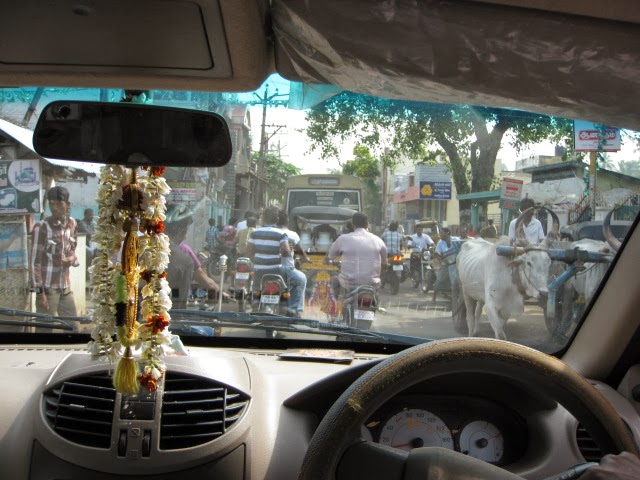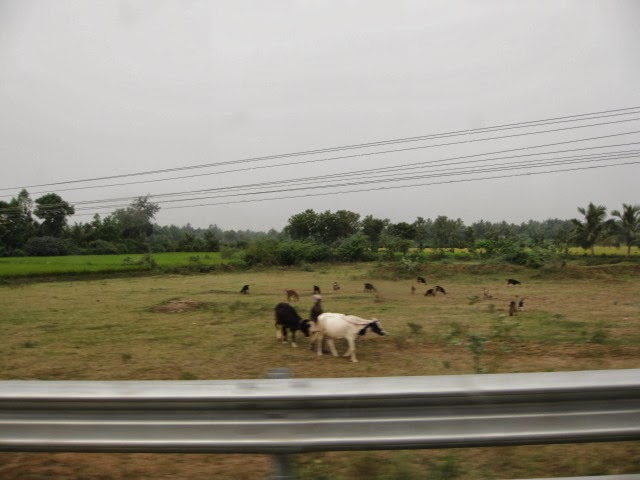During our recent trip to India, we had two places (besides our uncle's house in Chennai) that we needed to get to. The most important, and the reason for our trip, was our dad's village outside of Kumbakonam, the town that was the subject of last week's post. The second, which wasn't actually on the agenda until after we got to Chennai, was the city of Pondicherry (I hope to have a post of that trip up next week). My dad went to medical school there, and my mom and aunt wanted to show us the town and where he went to school. Given the distances from Chennai - 270 km and 160 km respectively - and our limited time in India, hiring a car and driver was our only real option, which meant time for a road trip. When you think of driving in India, you probably think of the photo above, a scene of traffic and controlled chaos in a land of 1.2 billion people. Once you get out of the city, though, you'll find a surprising amount of open space and farmland, along with glimpses of the country's culture that make it at once fascinating and somewhat frustrating. After the jump, enjoy a photo essay of our road trip to Kumbakonam and back (details of our trip to Pondicherry next week, hopefully).
The Eastern Ghats hills as we finally reach the outskirts of the city an hour and a half later.
The colorful village of Chengalpattu, about 60 km from Chennai, followed by a dry riverbed shortly thereafter (my mom says there's almost never any water in this river these days).
Continuing south, we came upon a huge gathering of devotees in a small village - thousands and thousands of them getting off buses parked all over the side of the road (I forgot the name of the village). Mom explained that a Kali temple has been built here, and attracts devotees from around the state. The color red represents the goddess Kali, the Hindu goddess of death, which is why the devotees are waring red clothes.
A typical view of the road - upgraded to a divided highway for the first 150 km or so.
A typical roadside "dhaba" (cafe) that you'll find everywhere in India off of the major highways. We stopped here for a tea/coffee break. I also had a chance to take a photo of the surrounding hills while we were stopped.
Now well south of Chennai, the landscape has turned largely into farmland.
Shortly thereafter, near the town of Viluppuram (160 km/100 mi from Chennai), we left the main highway and turned off onto a smaller, two-lane road that we would follow for the last 110 km (70 miles) of our trip. It didn't take long to encounter our first "livestock traffic jam".
My mom wanted to stop and buy some guavas a few minutes later, so I was able to take a photo of a typical stretch of rural highway here.
When I described the fascinating yet frustrating nature of India in the introduction, this is what I meant. I find villages like these fascinating, but at the same time, an open garbage dump at the side of the road? A little civic pride, folks?
As we head further south, we see fields of Tamil Nadu's primary cash crops - soybeans, sugarcane, and rice.
Next, the dusty, hectic town of Panruti, just as we were losing the last of the day's light. Panruti is known as THE place to get fresh cashews and jackfruits. The light was insufficient by this point, but the road was lined with street vendors selling both.
You can see here that although India's big cities have changed considerably over the last 20 years, rural India has remained largely the same.
The next day, after disposing of my dad's ashes in his village, we returned to Kumbakonam first before heading back to Chennai. The city was bustling on this Sunday morning, and you can see why India gets so congested - narrow streets built for bullock carts, not cars.
This was our hotel in Kumbakonam, the "Sara Residency". This fancy-pants hotel was apparently built to accommodate the growing number of tourists coming to town to view the area's historic temples.
We finally left town about 3:00. Not wanting a repeat of the complimentary lower lumbar adjustment we experienced on the drive in the night before, my aunt convinced the driver to take a different route that, while about 20 km longer, was reported to be in much better shape (it was). Along the way, we saw more of Tamil Nadu's peaceful, rural farmland.
This road was in much better shape, as you can see.
Another dry riverbed. The seasonal Northeast Monsoon (October - December) had failed, leading to a rainfall deficit of 40-50% across the state, and the attendant dry rivers.
We then spotted a troop of macaques (monkeys) on the side of the road. My mom and uncle decided to taunt them with an offer of bananas so they would pose for some photos.
In case you were wondering, offering food to monkeys isn't really a good idea. Number one, you're likely to attract the entire troop in a matter of seconds. Number two, macaques have a tendency to reach through car windows to grab whatever they can.
Stay tuned to this blog next week, as I'm planning on putting up a post about our trip to Pondicherry, including a stop at the heritage site of Mahabalipuram.
As mentioned above, the distance from Chennai to Kumbakonam is about 270 km (165 mi), but due to the poor state of India's rural roads, the trip takes a lot longer than you think. What would be a 3 hour trip here at home takes more than 6 in India; we left my aunt's house a few minutes after two, and finally made it to her second house in Kumbakonam a little after 8:30. I like to joke that half of that time is spent just getting out of Chennai, which actually isn't far from the truth...
Anyway, we start off with this old church on the south side of Chennai.
The colorful village of Chengalpattu, about 60 km from Chennai, followed by a dry riverbed shortly thereafter (my mom says there's almost never any water in this river these days).
Continuing south, we came upon a huge gathering of devotees in a small village - thousands and thousands of them getting off buses parked all over the side of the road (I forgot the name of the village). Mom explained that a Kali temple has been built here, and attracts devotees from around the state. The color red represents the goddess Kali, the Hindu goddess of death, which is why the devotees are waring red clothes.
A typical view of the road - upgraded to a divided highway for the first 150 km or so.
A typical roadside "dhaba" (cafe) that you'll find everywhere in India off of the major highways. We stopped here for a tea/coffee break. I also had a chance to take a photo of the surrounding hills while we were stopped.
Now well south of Chennai, the landscape has turned largely into farmland.
Shortly thereafter, near the town of Viluppuram (160 km/100 mi from Chennai), we left the main highway and turned off onto a smaller, two-lane road that we would follow for the last 110 km (70 miles) of our trip. It didn't take long to encounter our first "livestock traffic jam".
My mom wanted to stop and buy some guavas a few minutes later, so I was able to take a photo of a typical stretch of rural highway here.
When I described the fascinating yet frustrating nature of India in the introduction, this is what I meant. I find villages like these fascinating, but at the same time, an open garbage dump at the side of the road? A little civic pride, folks?
As we head further south, we see fields of Tamil Nadu's primary cash crops - soybeans, sugarcane, and rice.
Next, the dusty, hectic town of Panruti, just as we were losing the last of the day's light. Panruti is known as THE place to get fresh cashews and jackfruits. The light was insufficient by this point, but the road was lined with street vendors selling both.
You can see here that although India's big cities have changed considerably over the last 20 years, rural India has remained largely the same.
The next day, after disposing of my dad's ashes in his village, we returned to Kumbakonam first before heading back to Chennai. The city was bustling on this Sunday morning, and you can see why India gets so congested - narrow streets built for bullock carts, not cars.
This was our hotel in Kumbakonam, the "Sara Residency". This fancy-pants hotel was apparently built to accommodate the growing number of tourists coming to town to view the area's historic temples.
We finally left town about 3:00. Not wanting a repeat of the complimentary lower lumbar adjustment we experienced on the drive in the night before, my aunt convinced the driver to take a different route that, while about 20 km longer, was reported to be in much better shape (it was). Along the way, we saw more of Tamil Nadu's peaceful, rural farmland.
This road was in much better shape, as you can see.
Another dry riverbed. The seasonal Northeast Monsoon (October - December) had failed, leading to a rainfall deficit of 40-50% across the state, and the attendant dry rivers.
We then spotted a troop of macaques (monkeys) on the side of the road. My mom and uncle decided to taunt them with an offer of bananas so they would pose for some photos.
In case you were wondering, offering food to monkeys isn't really a good idea. Number one, you're likely to attract the entire troop in a matter of seconds. Number two, macaques have a tendency to reach through car windows to grab whatever they can.
Stay tuned to this blog next week, as I'm planning on putting up a post about our trip to Pondicherry, including a stop at the heritage site of Mahabalipuram.































good photography...keep sharing
ReplyDeleteBook online bus ticket from Redbus